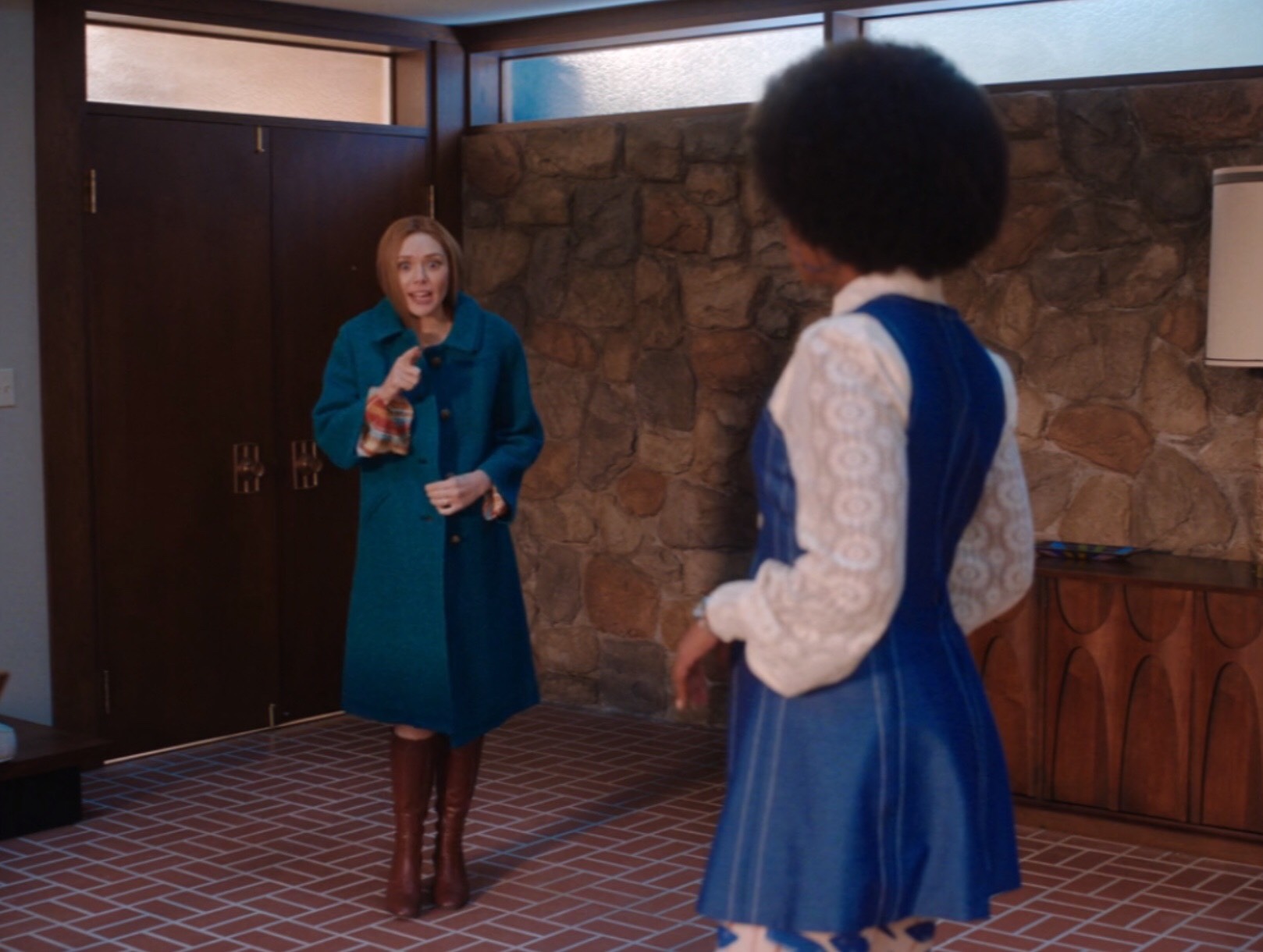How hidden ‘Loki’ costume details supported Sophia Di Martino
And the long-running history of pregnancy and postpartum adjustments in film and TV.

When Loki actress Sophia Di Martino auditioned for the role of Sylvie in 2019, she did so on an audition tape. Even before COVID made us all go virtual, this was not an unusual step for casting directors. However, to land a part on a show of this size without a screen test is less common. “I did an audition tape with a very short scene. I wasn’t asked to do it again, and I couldn’t meet anyone because I was heavily pregnant at the time and I couldn’t travel,” Di Martino told Variety last month about how she got the Marvel gig. Everyone else involved in production (including Tom Hiddleston) was in the U.S. and because she was unable to travel, she scored the role without meeting her co-star IRL. Working around (or during) pregnancy is industry standard, but now Di Martino has revealed how costume designer Christine Wada took her breastfeeding into account when crafting Sylvie’s suit.
Creating a visual language through garments is only one part of the costume designer’s job. Yes, this is vital to both the specific character in question and the overall narrative, but other factors such as safety, comfort, and budget all come into play. From cooling systems to keep an actor from overheating to pads that protect, the details the viewer doesn’t see are no less important. Sylvie’s costume is a twist on the look we have previously seen Tom Hiddleston sporting as the God of Mischief — he has spent most of the season so far in a TWA uniform — and the new star posted a behind-the-scenes image on Twitter and Instagram demonstrating how Wada designed the unseen components to support her breastfeeding requirements:
“It’s not easy being a working Mama! Genius #christinewada designed Sylvie’s costume & added concealed zippers so I could pump easily & nurse my baby between takes. Little (big) things like this that made it possible for me to do my job & be a parent. I’m forever grateful.”
Hollywood (and society) has come a long way since Lucille Ball became the first actress to have her real-life pregnancy written into a series in 1952 on I Love Lucy, but Di Martino’s post about Wada making this time-saving (and comfortable) adjustment is still notable. Of course, the film and TV industry is far from the only workplace where new mothers have to make considerations of this kind, but this level of visibility and acknowledgment spreads the message far and wide. On a recent episode of Bowen Yang and Matt Rogers’ excellent pop culture podcast series, Las Culturistas, guest Busy Philipps discussed how quickly actors go back to set after giving birth or illness. Unlike the current climate and COVID protocols — that meant she couldn’t work on part of the Girls5eva episode that Yang guest-starred on — production schedules rarely leave much wiggle room for sickness, injury, or those who have just given birth. “You go immediately back to shooting,” Philipps explained about working on Cougar Town after having a baby. On another occasion, while shooting this series, she recalled working through extreme pain after throwing out her back (her child was only a year and a half old at the time so her stomach muscles were weakened). “I had to rally, go do the scenes, and then go lay on the floor and cry,” she said about this particular injury.
A cliche, but time is money, and Philipps theorized that Elizabeth Taylor’s demands during the shooting of Cleopatra (which almost bankrupted Fox) influenced this attitude. She cited a Vanity Fair article from 1998, which mentions how director Joseph L. Mankiewicz “reportedly shuffled shooting schedules to accommodate her menstrual cycle.” Co-star Kenneth Haigh is quoted saying that Taylor's reason was to aid the picture, “She said, ‘Look, if I’m playing the most beautiful woman in the world, I want to look my best.’” Taylor wasn’t the only one to have a “period” clause like this in her contract as an unnamed starlet (rumored to be either Lana Turner or Vivien Leigh) discussed in David Niven’s Bring on the Empty Horses is quoted saying, “I get three days off when it comes.” Hollywood will scrutinize appearance for the most arbitrary of reasons — and the agents working for these women made sure to utilize this loophole.

I bring this up in relation to Di Martino’s costume post in 2021 to show the shifts in attitude toward everything pertaining to periods, pregnancy, and postpartum matters. When pregnancy isn’t written into a character’s arc there are tricks to concealing the bump including props and costumes — WandaVision hilariously pointed to the use of both in its third episode. While coats are common aid, when I discussed Keri Russell’s real-life pregnancy in The Americans, costume designer Katie Irish explained heavier cable knits are a bump concealing hack (before outwear came into play). Where the budget allows for it, CGI has also been used on shows like The Americans and Homeland to erase the real-life condition. The latter was utilized when a five-month pregnant Gal Gadot was required for Wonder Woman reshoots. Here, Lindy Hemming’s costume gained an extra green panel for post-production reasons. "On wide shots, I looked very funny, like Wonder Woman pregnant with Kermit the Frog," Gadot told Entertainment Weekly in 2017. Costume designers are often the unsung heroes (and are still fighting for pay equity), so Di Martino shouting out Wada specifically goes a long way in an industry that often neglects to credit the designer.
When Lucille Ball found out she was pregnant before the second season of I Love Lucy went into production, she thought this might mean the end of the show. Head writer Jess Oppenheimer had another idea, which Ball recounts in her autobiography Love, Lucy. “I wouldn’t suggest this to any other actress in the world — but why don’t we continue the show and have a baby on TV?” The censors at CBS were consulted, as well as a priest, a minister, and a rabbi to ensure it would be “tasteful.” It is truly mind-boggling that this was required in the first place, and it was the network that had an issue with the word “pregnant” — “expecting” was used in its place.
The latest updates, reviews and unmissable series to watch and more!
The rest is TV history as the birth of Ricky Ricardo Jr. (on the same day as Desi Arnaz Jr.) set records at the time with 44 million tuning in to watch (the audience share was a whopping 71.7% of US households). There is so much talk about Ball’s onscreen pregnancy that I was surprised to find out that she started filming Season 1 only six weeks after giving birth to her first child in 1951. This doesn’t take into account preproduction as Ball recounts in Love, Lucy, “I had to go right back to work after Lucie was born, so I missed hours and hours and hours of her earliest life. While she got two months off after her second baby, to ensure they had enough episodes to fill the gap it meant working 10-12 hour days, six days a week during the summer. Of course, there is no discussion about breastfeeding (or needing costume adjustments beyond maternity wear).
Nearly 70 years after “Lucy Goes to the Hospital” first aired, a pregnant working actress is a norm. Less is said about juggling a new baby and working — the tabloid obsession with post-baby bodies is exhausting — and there are elements that are discussed with less frequency. Of course, this is an industry that does have some flexibility with having your family in the vicinity, but this additional alteration by Christine Wada is a heartwarming choice. In sharing the specificity of this custom-build design, Di Martino is adding to a very long and important conversation.
Emma Fraser spends most of her time writing about TV, fashion, and costume design; Dana Scully is the reason she loves a pantsuit. Words can also be found at Vulture, Elle, Primetimer, Collider, Little White Lies, Observer, and Girls on Tops. Emma has a Master’s in Film and Television, started a (defunct) blog that mainly focused on Mad Men in 2010, and has been getting paid to write about TV since 2015. It goes back way further as she got her big start making observations in her diary about My So-Called Life’s Angela Chase (and her style) at 14.


